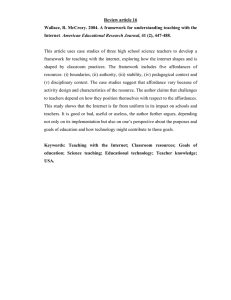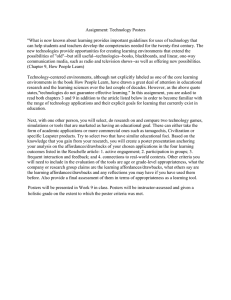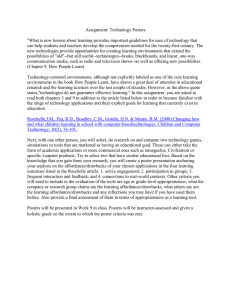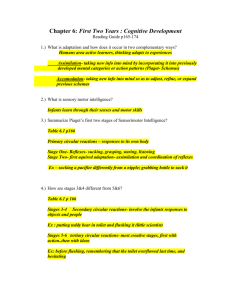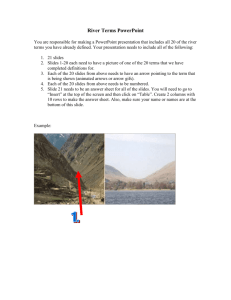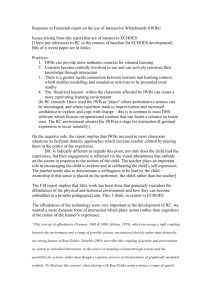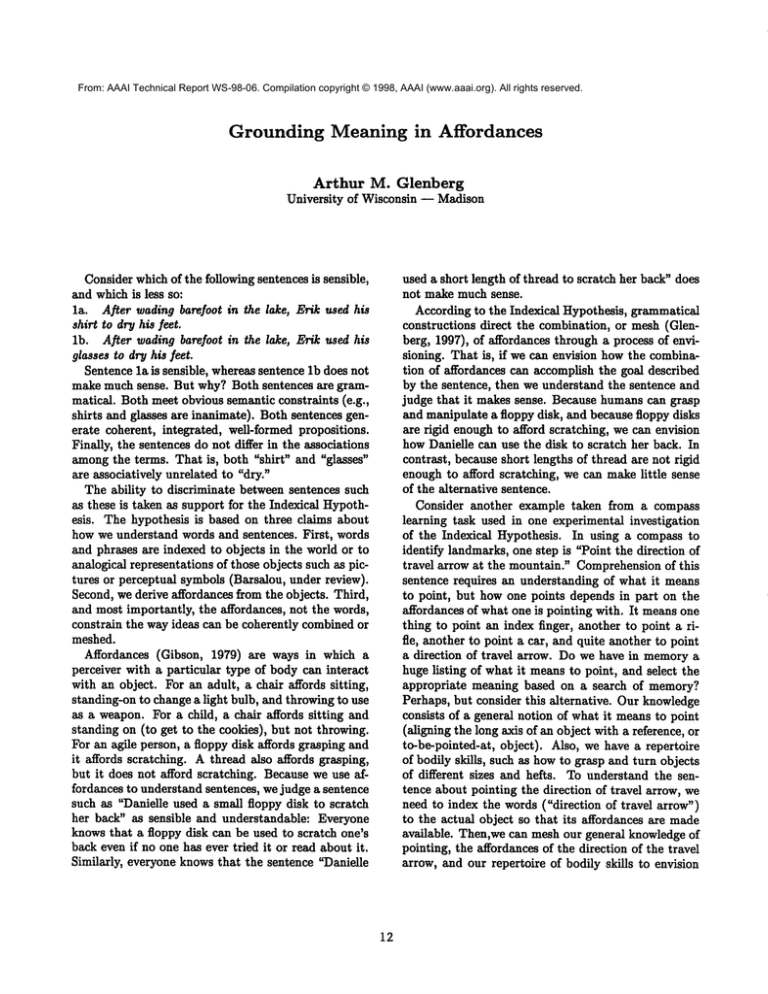
From: AAAI Technical Report WS-98-06. Compilation copyright © 1998, AAAI (www.aaai.org). All rights reserved.
Grounding Meaning in Affordances
Arthur
M. Glenberg
University of Wisconsin -- Madison
used a short length of thread to scratch her back" does
not make much sense.
According to the Indexical Hypothesis, grammatical
constructions direct the combination, or mesh (Glenberg, 1997), of affordances through a process of envisioning. That is, if we can envision how the combination of affordances can accomplish the goal described
by the sentence, then we understand the sentence and
judge that it makes sense. Because humans can grasp
and manipulate a floppy disk, and because floppy disks
are rigid enough to afford scratching, we can envision
how Danielle can use the disk to scratch her back. In
contrast, because short lengths of thread are not rigid
enough to afford scratching, we can make little sense
of the alternative sentence.
Consider another example taken from a compass
learning task used in one experimental investigation
of the Indexical Hypothesis. In using a compass to
identify landmarks, one step is "Point the direction of
travel arrow at the mountain." Comprehensionof this
sentence requires an understanding of what it means
to point, but how one points depends in part on the
affordances of what one is pointing with. It means one
thing to point an index finger, another to point a rifle, another to point a car, and quite another to point
a direction of travel arrow. Do we have in memorya
huge listing of what it means to point, and select the
appropriate meaning based on a search of memory?
Perhaps, but consider this alternative. Our knowledge
consists of a general notion of what it means to point
(aligning the long axis of an object with a reference, or
to-be-pointed-at, object). Also, we have a repertoire
of bodily skills, such as howto grasp and turn objects
of different sizes and hefts. To understand the sentence about pointing the direction of travel arrow, we
need to index the words ("direction of travel arrow")
to the actual object so that its affordances are made
available. Then,we can mesh our general knowledge of
pointing, the affordances of the direction of the travel
arrow, and our repertoire of bodily skills to envision
Consider which of the following sentences is sensible,
and whichis less so:
la. After wading barefoot in the lake, Erik used his
shirt to dry his feet.
lb. After wading barefoot in the lake, Erik used his
glasses to dry his feet.
Sentence la is sensible, whereas sentence lb does not
make much sense. But why? Both sentences are grammatical. Both meet obvious semantic constraints (e.g.,
shirts and glasses are inanimate). Both sentences generate coherent, integrated, well-formed propositions.
Finally, the sentences do not differ in the associations
amongthe terms. That is, both "shirt" and "glasses"
are associatively unrelated to "dry."
The ability to discriminate between sentences such
as these is taken as support for the Indexical Hypothesis. The hypothesis is based on three claims about
how we understand words and sentences. First, words
and phrases are indexed to objects in the world or to
analogical representations of those objects such as pictures or perceptual symbols (Barsalou, under review).
Second, we derive affordances from the objects. Third,
and most importantly, the affordances, not the words,
constrain the way ideas can be coherently combined or
meshed.
Affordances (Gibson, 1979) are ways in which
perceiver with a particular type of body can interact
with an object. For an adult, a chair affords sitting,
standing-on to change a light bulb, and throwing to use
as a weapon. For a child, a chair affords sitting and
standing on (to get to the cookies), but not throwing.
For an agile person, a floppy disk affords grasping and
it affords scratching. A thread also affords grasping,
but it does not afford scratching. Because we use affordances to understand sentences, we judge a sentence
such as "Danielle used a small floppy disk to scratch
her back" as sensible and understandable: Everyone
knowsthat a floppy disk can be used to scratch one’s
back even if no one has ever tried it or read about it.
Similarly, everyone knows that the sentence "Danielle
12
information. The Read group performed slightly better than the Index group on a verbal test of the background information. In the second phase of the experiment, the two groups read instructions for how to use
the compass, such as "Point the direction of travel arrow at the mountain." The participants in the Index
condition read the new instructions about 25%faster
than the participants in the Read condition. Furthermore, the Index participants performed the task significantly more accurately. Thus, indexing words to
objects in the first phase of the experiment greatly facilitated comprehensionof instructions regarding those
objects during the second phase of the experiment.
a coherent set of actions that result in pointing the
direction of travel arrow at the mountain.
In contrast, if we did not knowthe affordances of a
direction of travel arrow, then we could not comprehended the sentence: Wewould not know how to act
on it. Or, if a direction of travel arrow did not afford
pointing (like the glasses in lb do not afford drying),
then the sentence would be nonsense. For example, if
a direction of travel arrow was a vector that indicated
the mean direction and duration in which one had been
walking, it is not clear what it wouldmeanto point this
vector at a mountain. Although the vector has a direction, it is not something that can be changed by the
usual actions of pointing.
The Indexical Hypothesis has several implications
for meanings of words. First, language understanding requires that the affordances of objects be readily
available. In turn, this requires that a componentof
word meaning be an analogical representation such as
a perceptual symbol. That is, word meaning cannot be
restricted to descriptions using arbitrary symbols and
their relations. Although the descriptions mayprovide
affordances for howan object is be used in some situations, an analogical representation is needed to derive
affordances for how the object might be used in novel
situations, such as using one’s shirt to dry one’s feet,
or using a floppy disk to scratch one’s back.
The indexical hypothesis has been tested in several
different types of experiments. In one experiment, participants were asked to judge the meaningfulness of
sentences such as la and lb. Of course, people were
quite good at this. Interestingly, the time it takes to
read sentences such as la was no longer than the time
to read a control sentence such as lc.
lc. After wading barefoot in the lake, Erik used his
towel to dry his feet.
This result demonstrates that people do not treat la
as unusual. It also demonstrates that the affordances
of shirts (that they can be used to dry feet) are not
derived from a long chain of inferential reasoning. Instead, the fact that a shirt affords drying is as readily
available as the fact that a towel affords drying. The
point is that using affordances is not a special or unusual comprehensionstrategy; it may well be the norm.
In a second type of experiment, participants were
asked to learn (from reading) how to perform a new
task, using a compass and map to identify landmarks.
In the first part of the experiment, participants learned
background information about parts of a compass, such
as the direction of travel arrow. Participants in the Index group were given the opportunity to index terms
to an actual compass. Participants in the Read group
were given the opportunity to reread the background
References
Barsalou, L (under review). Perceptual symbol systems.
Gibson, J. J. (1979). The ecological approachto visual
perception. NewYork: Houghton Mifflin.
Glenberg, A. M. (1997). What memoryis for. Behavioral and Brain Sciences, 20, 1-19.
13

